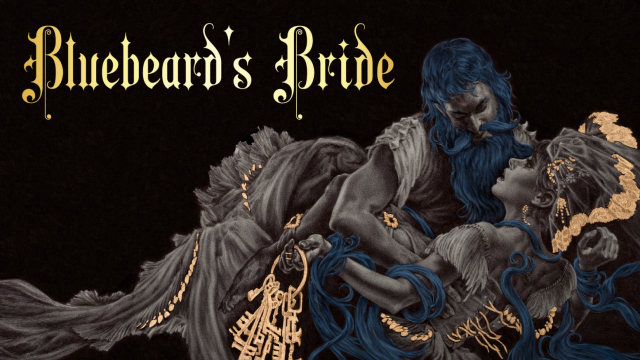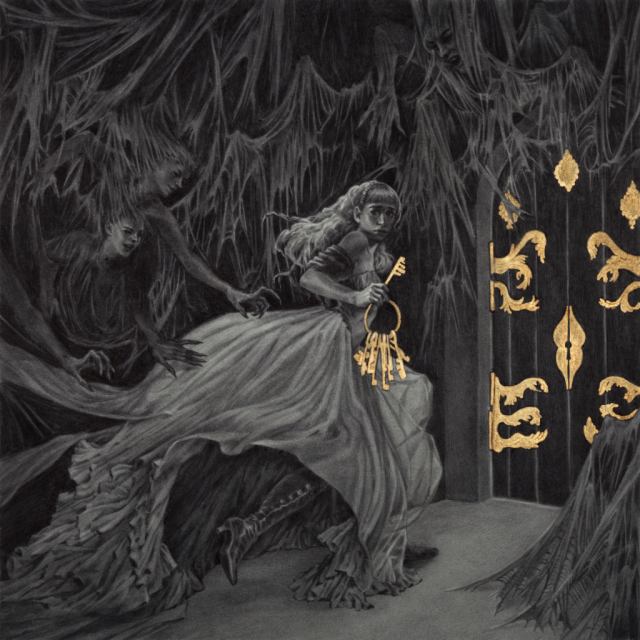The sunroom is full of bright green plants and birdcages with colorful songbirds. From an old-fashioned gramophone comes the sound of a woman singing plaintively in an unknown language, and there is a tea cart with a shiny silver tea service… The birds go silent, and you can feel them watching you. You can see the birds reflected in the silver teapot. Only they’re not birds. Broken-looking women are stuffed into those cages, looking at you. They are wearing evening dresses made out of feathers. One of the bird-women whispers to you, “Do you sing as lovely as we did, little Bride…?”

Several weeks ago, just before my life took a decided plunge into Grief Valley, I received my copy of Bluebeard’s Bride, a brand-new roleplaying game I had backed during its Kickstarter campaign last year. Produced by Magpie Games, and written and designed by Whitney “Strix” Beltrán, Marissa Kelly, and Sarah Richardson, Bluebeard’s Bride is, simply put, a masterpiece of its kind. I expected great things from this project when I first backed it, and I am in no way disappointed with the results.
A gorgeously illustrated psychodrama faerie-tale in which the players take on the roles of aspects within a single woman’s psyche, Bluebeard’s Bride presents a radical take on the now-familiar RPG medium. The situation is simple: You are the new bride of a wealthy yet sinister nobleman. Before he goes away on business, he gives you the set of keys to a monumental estate, warning you that all rooms save one are open to you. As you explore the grounds, the surreal horrors you discover force you toward one of two conclusions: either your husband is a haunted yet innocent man, or you married a monster. Either way, his horrors are now your own. So will you enter that final, forbidden chamber… and if you do, will you do so believing your husband to be innocent or guilty?
Rather than playing individual personas, the players – save one, who becomes the Groundskeeper improvising the rooms and horrors you encounter – assume Jungian archetypes within the Bride’s self. Each archetype, or face, has certain strengths, weaknesses, agendas, and “moves” – that is, things they can do that the others cannot do. The game is a communal, cooperative, improvisational experience in which the various “sisters” (archetypes) explore Bluebeard’s home, shifting from sister to sister as the situation demands.
In place of the conventional “dungeon-crawl” in which the players wander through a pre-planned series of levels, traps and opponents, Bluebeard’s Bride involves all players in each element of the story. The rooms get conjured from the imagination of the group as a whole, inspired by the keys that unlock them. At the door of each room, the Groundskeeper asks the player who’s holding the key what it looks like; based upon that description, and the themes evoked by the players and their personas, the Groundskeeper describes what lies beyond that door. (See the opening paragraph of this review.) A series of questions invites the players to detail the room and the Bride’s reaction to it. Inevitably, some feature of that room adds to the cascade of dread which drives the Bride from room to room. Every game, therefore, is different – a product of the people who play it and the circumstances in their lives at that time.
The horrors deepen as the game progresses. Certain events inflict trauma: mental and emotional wounds that threaten to tear the Bride’s psyche apart. Certain choices can heal or limit trauma, but a degree of fracturing becomes inevitable. As players lose their aspects to the torments of Bluebeard’s home, they become narrators who aid the Groundskeeper in the growing nightmare of the Bride’s journey. That Bride, meanwhile, becomes less able to sustain further harm… and yet, as the saying goes, she persists, wherever such persistence eventually leads.
Bluebeard’s Bride is an unapologetic horror game; regardless of the gender of the players involved, the terrors of the female condition are its primary theme. This isn’t a game where you get to kick Bluebeard’s ass, though. Instead, you’re limited by the role in which society has cast you, and must work with what you have, not with the mighty powers of wish-fulfillment RPGs. Those limitations make Call of Cthulhu, by comparison, look like Candyland. There are no rocket launchers or magical texts to rescue you from the threats you encounter. This is a game of mood and consensual torment, with the only real salvation being the x-card: an opportunity to safeword out of the story’s most upsetting elements if you so choose. For that reason, among others, I consider this to be the best evocation of horror (in the sense of pervasive dread and genuine danger) I’ve found in any RPG. Other games, including those I’ve worked on, invoke the trappings of horror in a context of adventure. In Bluebeard’s Bride, horror is implacable, remorseless, and typically fatal.
That inevitability may be the game’s greatest flaw: even if you survive the house, your role in society negates any form of “winning” in the usual sense of a game. For some players, this dismal prospect would take the fun out of the experience. From a creative standpoint, though – and certainly from an artistic one – the Bride’s powerless situation is essential to the story. The house is a metaphor for the pitfalls of humanity in general and women in particular, and so “heroism” in this situation isn’t based on wiping out the bad guy so much as it’s about how you handle the realization of just how you truly fucked are.

Production-wise, the book is well-written, clear, concise, and visually beautiful. The artwork – by Rebecca Yanovskya, Kring, Juan Ochoa, Miguel Angel Espinoza, Mirco Paganessi, and Tawny Fritz – echoes the ominous sensuality of Decadent art and Victorian faerie-tale collections. Its prose, meanwhile, evokes the condescending manners of Victorian high society, constantly reminding the reader of her lowly state in the grand scheme of things. Every element of Bluebeard’s Bride reinforces the genteel claustrophobia of the social cage trapping our Bride. In the polar opposite of conventional power-fantasies, this game conjures its horrors from disempowerment – the key difference between supernatural action thrillers and tales of genuine unease. As I’ve written elsewhere, horror is, at its core, about facing mortality and realizing we’ll never truly get out alive.
The game’s system is simple and improvisational, suiting the story-telling nature of Bluebeard’s Bride and its genre far better than the mechanics-heavy systems of other horror-themed games… including White Wolf’s own familiar Storyteller system. It demands an imaginative group whose players trust each other and sign on for the experience, and so it’s not remotely a game for all tastes. For all intents and purposes, you’re doomed from the start simply for existing, and although the game can end several different ways, none of them is exactly the proverbial happy ending. This is NOT the feel-good game of the year, and only certain types of players will appreciate what it has to offer.
As should be obvious, this isn’t a game for kids.
As an exploration and expansion of the RPG medium, though, and as a tool for macabre psychodrama fantasy, I consider Bluebeard’s Bride one of the finest roleplaying games I’ve ever seen. If nothing else, it’s a magnificent example of what RPGs can become when they graduate from orc-killing wish-fulfillment, and embrace the psychological potential of persona-based storytelling art.
Congratulations to everyone involved. I can’t wait to see what you folks come up with next.

